CD3 antibody | UCHT1






































































































































































































































































































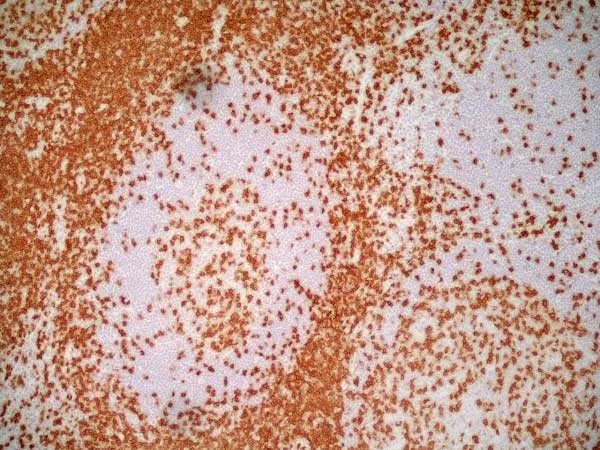



FITC conjugated Mouse anti Human CD3 antibody, clone UCHT1 (MCA463G) used for the evaluation of CD3 expression on human PBMC by flow cytometry.
Image caption:
Expression of RANTES in obese subjects. (a) Western blot analysis of RANTES expression in PBMCs from lean and obese subjects. The bands reacting with anti-RANTES antibody were quantified as described in Section 2 and the relative intensity was determined after correction with Actin that was used as internal control to monitor loading efficiency. The blots shown are representative of three independent experiments with consistent results. The data are presented in the form of a bar graph on the right of the figure as fold changes of RANTES protein expression in obese compared to lean subjects. (b) Characterization of the monocyte subpopulations and T cells in peripheral blood from lean and obese participants. Monocytes subsets were defined by staining for CD14 (PE), T cells by CD3 (FITC), and expression of intracellular RANTES (APC) was analyzed. Left and right upper panels are representative dot plots of CD3 and RANTES expression on/in T cells from lean and obese participants, respectively. Left and right lowest panels are representative dot plots of CD14 and RANTES expression on/in monocyte subsets from lean and obese participants, respectively. The double-positive populations (i.e., CD3+RANTES+, CD14+RANTES+, and CD14++RANTES+) were analyzed for mean RANTES fluorescence intensity.
From: Engin Baturcam, Jehad Abubaker, Ali Tiss, et al..
“Physical Exercise Reduces the Expression of RANTES and Its CCR5 Receptor in the Adipose Tissue of Obese Humans,”
Mediators of Inflammation, vol. 2014, Article ID 627150, 13 pages, 2014.
This image is from an open access article distributed under the terms of a Creative Commons Attribution License.

FITC conjugated Mouse anti Human CD3 antibody, clone UCHT1 (MCA463G) used for the evaluation of CD3 expression on human PBMC by flow cytometry.
Image caption:
Differential regulation of CCR5 in PBMCs and adipose tissue is associated with obesity. (c) Characterization of the monocyte subpopulations and T cells in peripheral blood from lean and obese subjects. Monocytes subsets were defined by staining for CD14 (PE), T cells by CD3 (FITC), and expression of CCR5 (APC) and then were analyzed. Gates P4 and P3 define the CD14+ and CD14++ subsets, respectively. Left and right upper panels are representative dot plots of CD3 and CCR5 expression on T cells from lean and obese subjects, respectively. Left and right lower panels are representative dot plots of CD14 and RANTES expression on monocyte subsets from lean and obese participants, respectively. The double-positive populations (i.e., CD3+CCR5+, CD14+CCR5+, and CD14++CCR5+) were analyzed for mean CCR5 fluorescence intensity. For each experiment, the sample size from each group is indicated by n.
From: Engin Baturcam, Jehad Abubaker, Ali Tiss, et al.
“Physical Exercise Reduces the Expression of RANTES and Its CCR5 Receptor in the Adipose Tissue of Obese Humans,”
Mediators of Inflammation, vol. 2014, Article ID 627150, 13 pages, 2014.
This image is from an open access article distributed under the terms of a Creative Commons Attribution License.


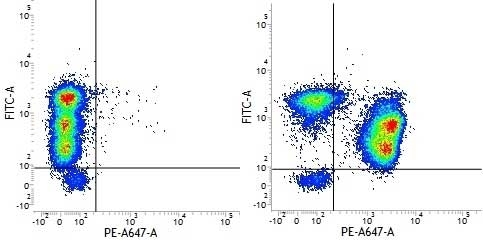
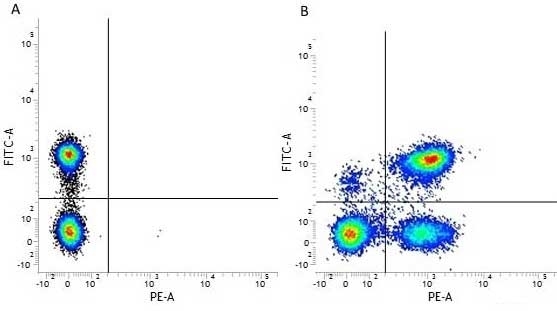




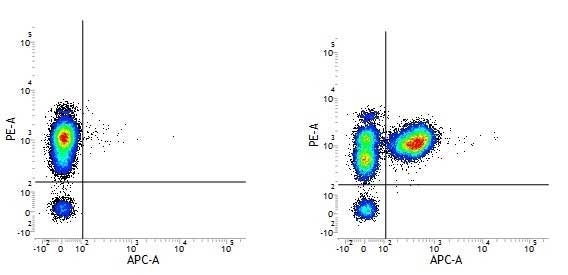





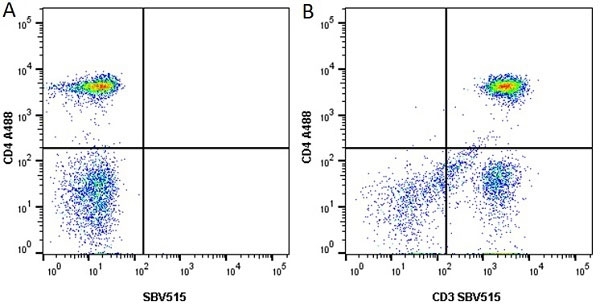

























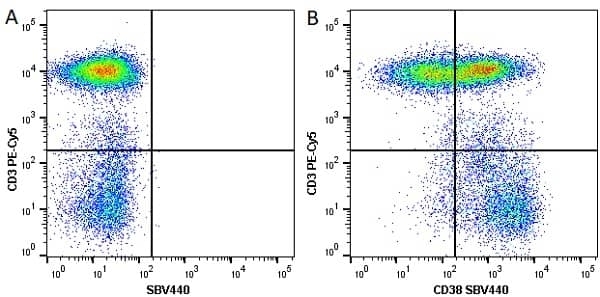

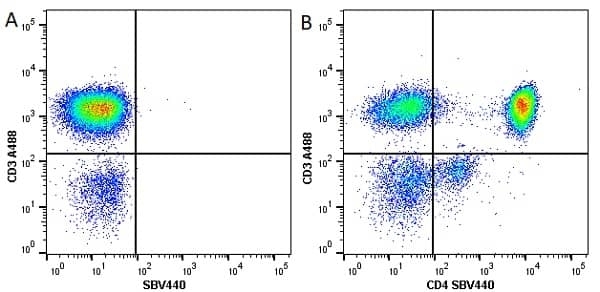





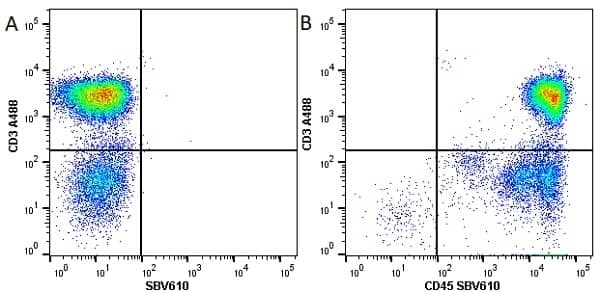















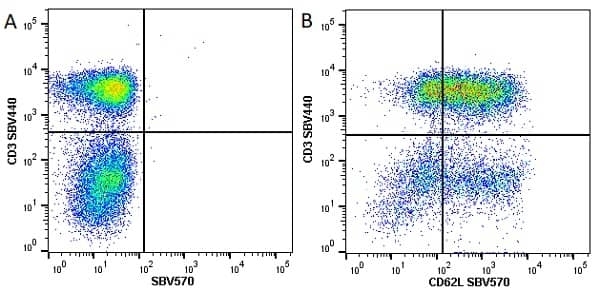



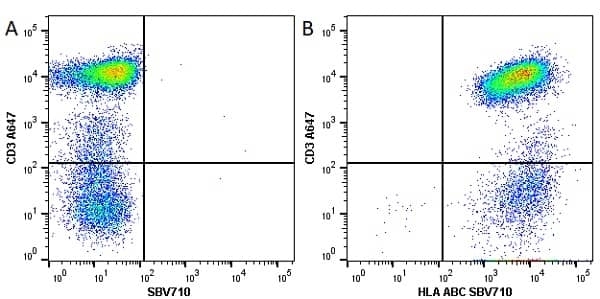













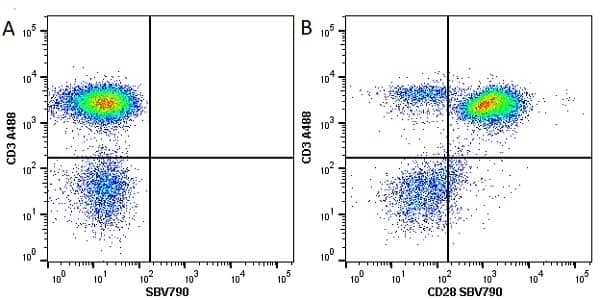







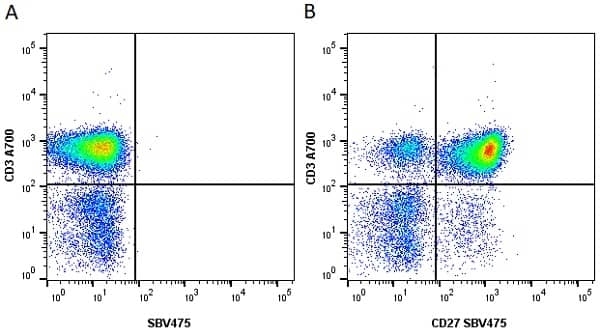




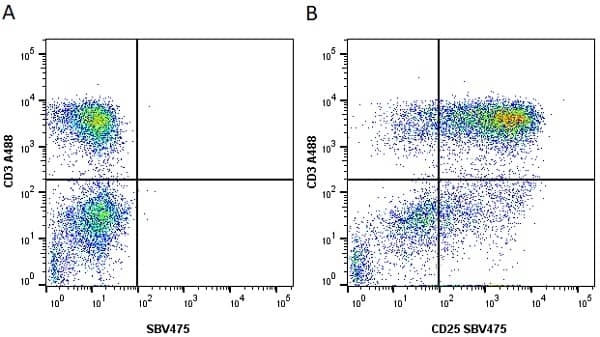









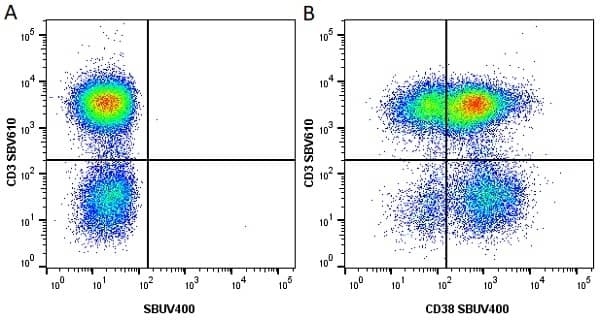



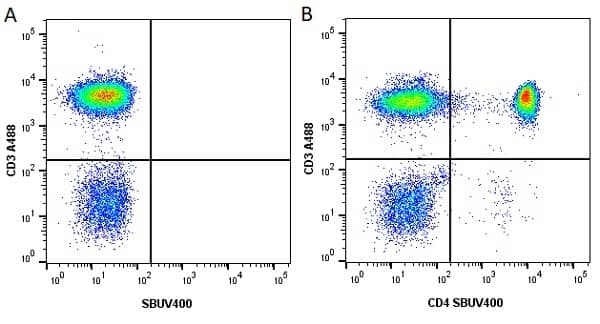











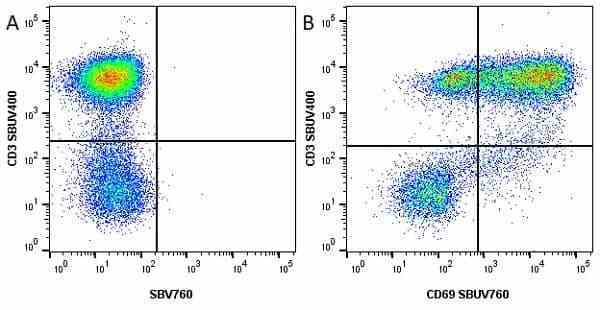







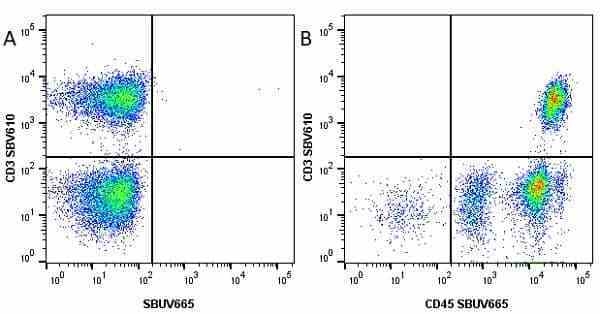

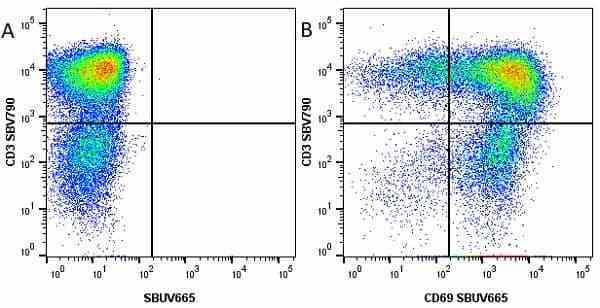












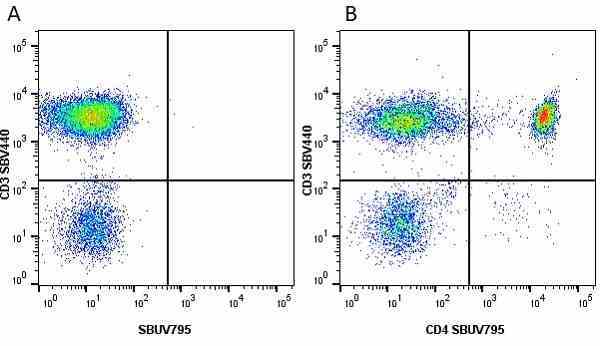

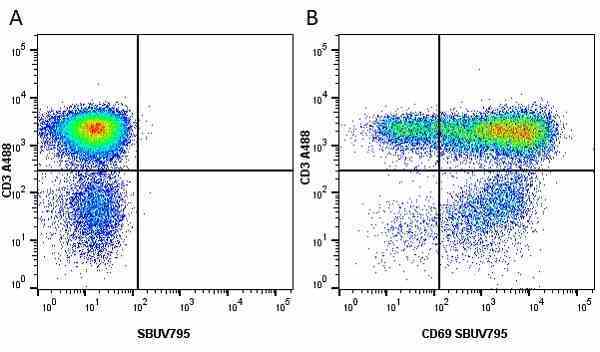















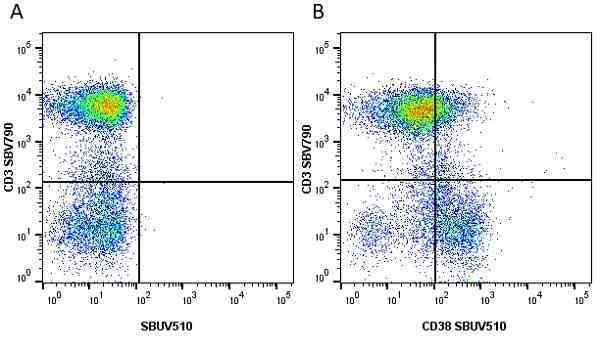






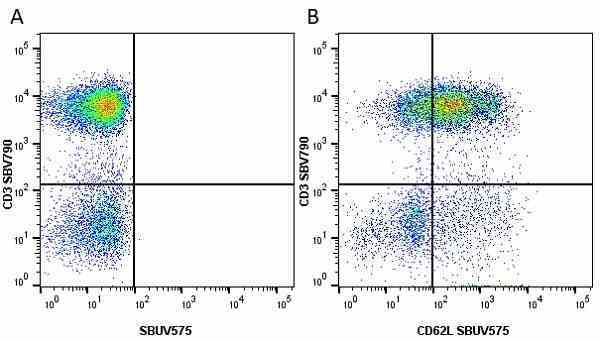


















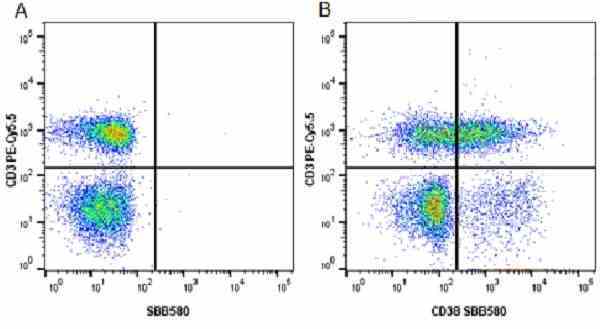

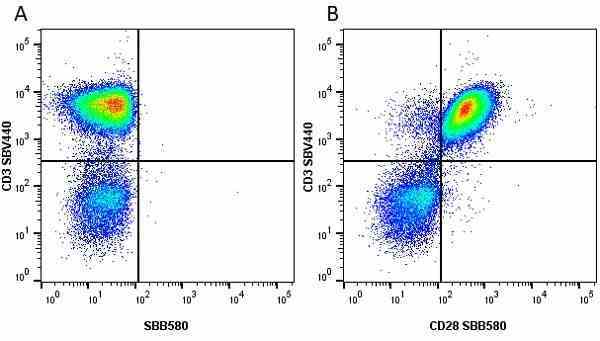




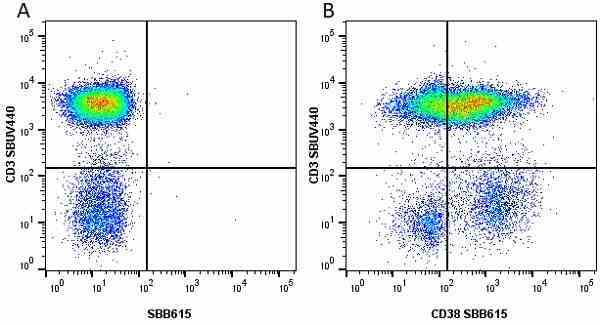


















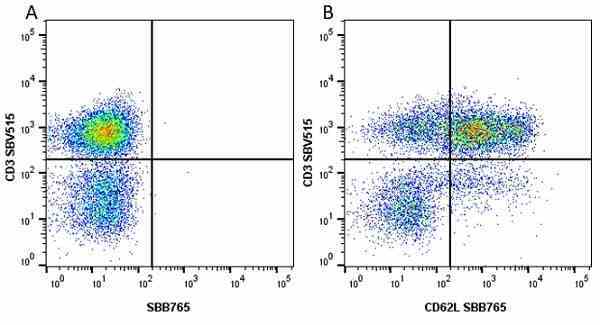




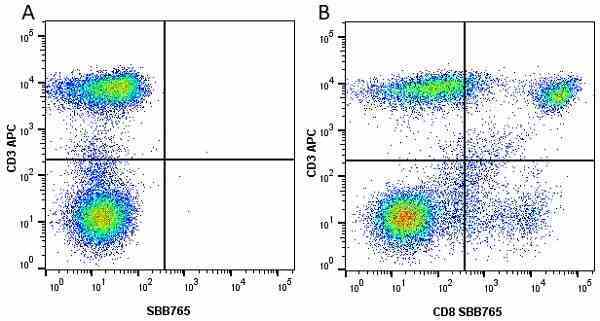






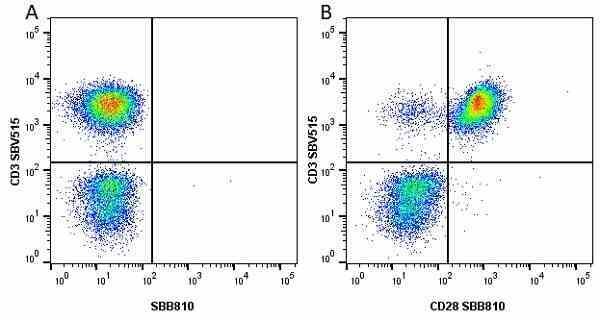














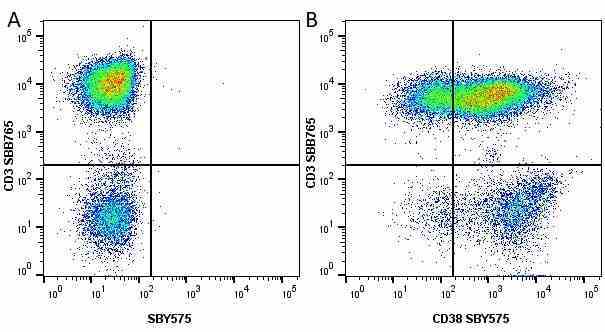

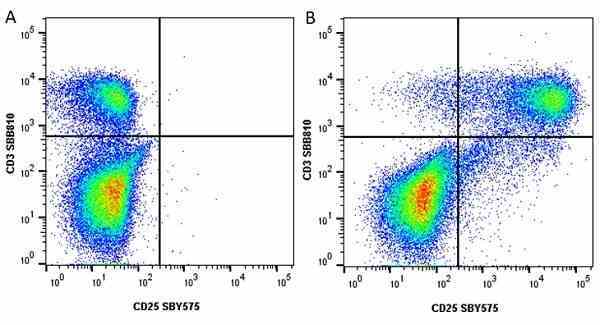
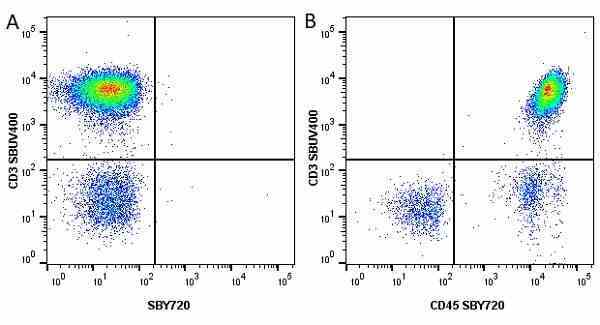



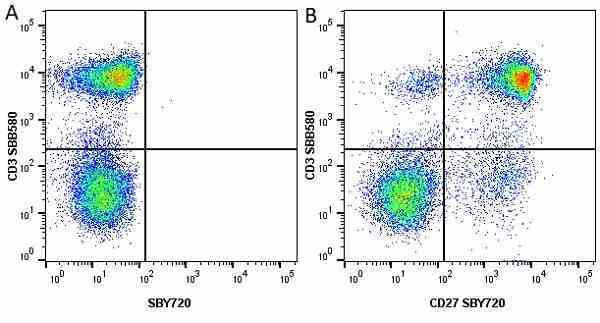
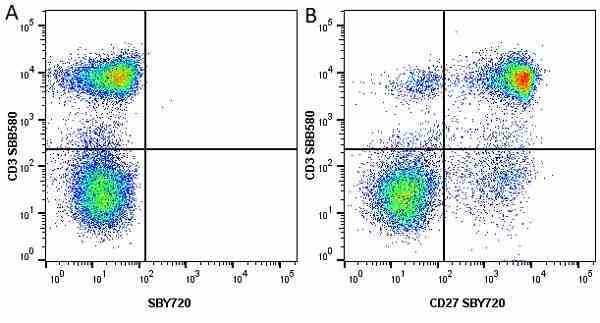
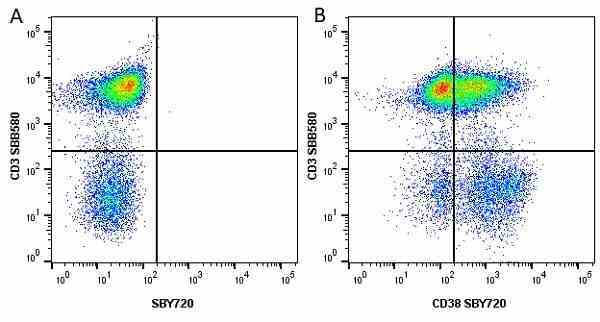
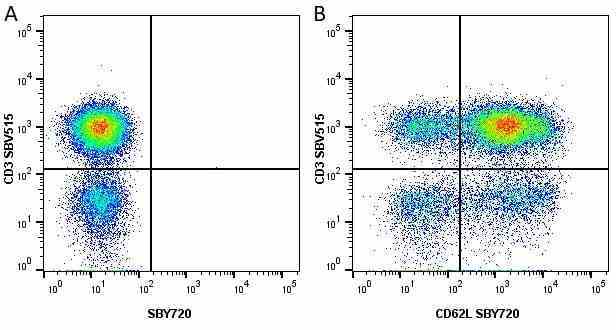





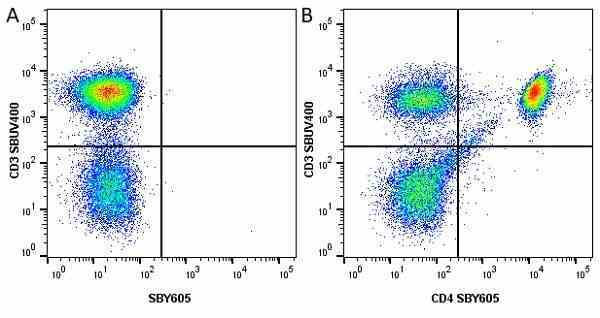

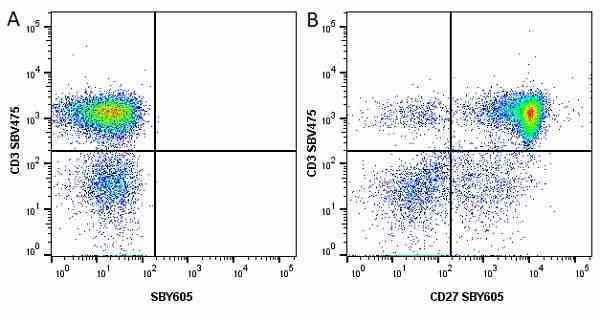








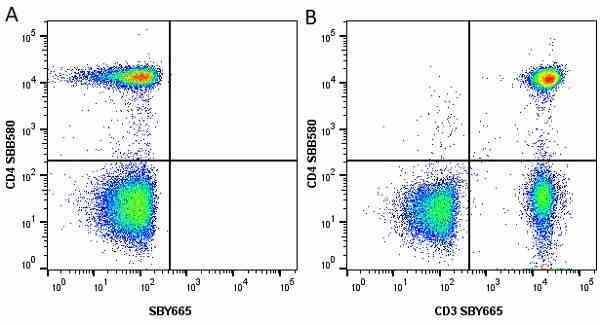


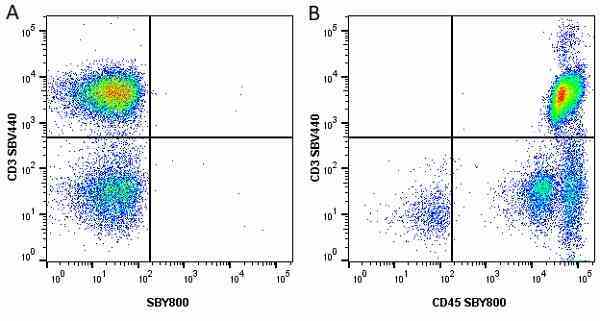
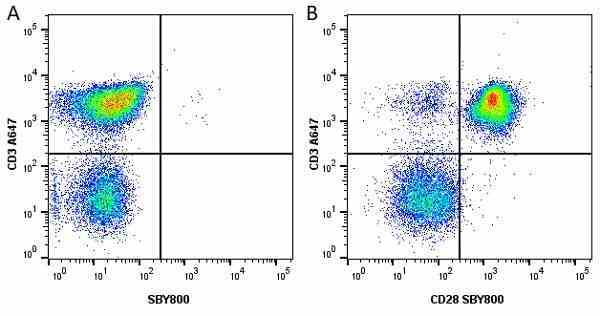
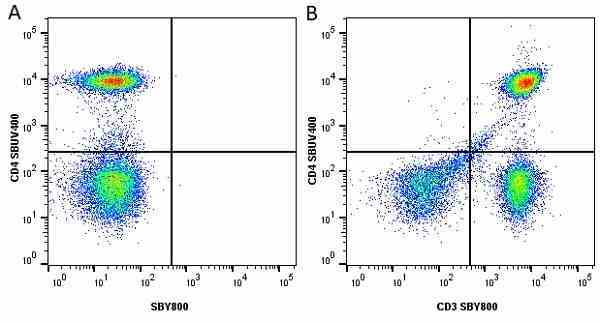
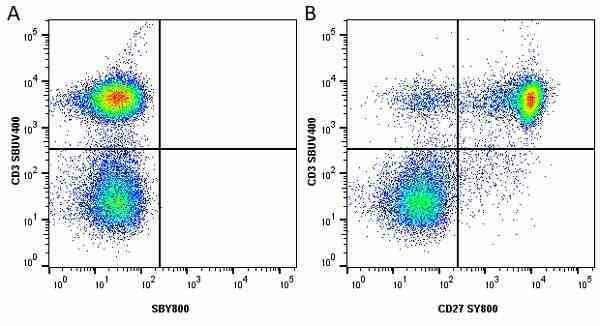


Mouse anti Human CD3:FITC
- Product Type
- Monoclonal Antibody
- Clone
- UCHT1
- Isotype
- IgG1
- Specificity
- CD3
| Mouse anti Human CD3 antibody, clone UCHT1 recognizes the human T-cell surface glycoprotein CD3 epsilon chain, also known as T-cell surface antigen T3/Leu-4 epsilon chain or CD3ε. CD3ε is a 207 amino acid, ~21kDa single pass type 1 transmembrane protein containing a single Ig-like and a single ITAM domain. Mouse anti Human CD3 antibody, clone UCHT1 was originally described as only binding to CD3ε when complexed with either the CD3δ or CD3γ subunits, as indicated by co-transfection immunofluorescence on COS cells (Salmerón et al. 1991). Mouse anti Human CD3 antibody, clone UCHT1 binds to a region in the ectodomain of human CD3ε and binds to a discontinuous epitope near an acidic region of CD3ε opposite the dimer interface; as shown by crystallography of the CD3ε/δ dimer complexed with a single chain UCHT1 antibody fragment (Arnett et al. 2004). CD3 is expressed by all T lymphocytes and is seen in all lymphoid organs including lymph nodes and spleen. It is involved in thymocyte differentiation (Brodeur et al. 2009). Deficiency of the CD3ε chain contributes to blocking T-cell development and presentation of a severe combined immunodeficiency phenotype (Fischer et al. 2005). Mouse anti Human CD3 antibody, clone UCHT1 has been used successfully for the activation of human peripheral blood lymphocytes by cross linking and subsequently for CD3ε surface expression by flow cytometry (Hirsh and Cohen 2006). |
- Target Species
- Human
- Species Cross-Reactivity
-
Target Species Cross Reactivity Chimpanzee - N.B. Antibody reactivity and working conditions may vary between species.
- Product Form
- Purified IgG conjugated to Fluorescein Isothiocyanate Isomer 1 (FITC) - liquid
- Preparation
- Purified IgG prepared by affinity chromatography on Protein A from tissue culture supernatant
- Buffer Solution
- Phosphate buffered saline
- Preservative Stabilisers
0.09% Sodium Azide 1% Bovine Serum Albumin - Immunogen
- Human infant thymocytes and lymphocytes from a patient with Sezary Syndrome.
- Approx. Protein Concentrations
- IgG concentration 0.1 mg/ml
- Fusion Partners
- Spleen cells from immunized BALB/c mice were fused with cells of the P3/NS1/1-Ag4-1 mouse myeloma cell line.
- Max Ex/Em
-
Fluorophore Excitation Max (nm) Emission Max (nm) FITC 490 525 - Regulatory
- For research purposes only
- Guarantee
- 12 months from date of despatch
This product is shipped at ambient temperature. It is recommended to aliquot and store at -20°C on receipt. When thawed, aliquot the sample as needed. Keep aliquots at 2-8°C for short term use (up to 4 weeks) and store the remaining aliquots at -20°C.
Avoid repeated freezing and thawing as this may denature the antibody. Storage in frost-free freezers is not recommended. This product is photosensitive and should be protected from light.
Avoid repeated freezing and thawing as this may denature the antibody. Storage in frost-free freezers is not recommended. This product is photosensitive and should be protected from light.
This product has been reported to work in the following applications. This information is derived from testing within our laboratories, peer-reviewed publications or personal communications from the originators. Please refer to references indicated for further information. For general protocol recommendations, please visit the antibody protocols page.
| Application Name | Verified | Min Dilution | Max Dilution |
|---|---|---|---|
| Flow Cytometry | 1/10 |
Where this antibody has not been tested for use in a particular technique this does not necessarily exclude its use in such procedures. Suggested working dilutions are given as a guide only. It is recommended that the user titrates the antibody for use in their own system using appropriate negative/positive controls.
- Flow Cytometry
- Use 10ul of the suggested working dilution to label 106 cells or cells or 100ul whole blood.
| Description | Product Code | Applications | Pack Size | List Price | Your Price | Quantity | |
|---|---|---|---|---|---|---|---|
| Mouse IgG1 Negative Control:FITC | MCA928F | F | 100 Tests |
|
Log in
|
||
| List Price | Your Price | ||||||
|
|
Log in
|
||||||
| Description | Mouse IgG1 Negative Control:FITC | ||||||
| Description | Product Code | Applications | Pack Size | List Price | Your Price | Quantity | |
|---|---|---|---|---|---|---|---|
| Human Seroblock | BUF070A | F | 50 Test |
Log in
|
|||
| List Price | Your Price | ||||||
|
Log in
|
|||||||
| Description | Human Seroblock | ||||||
| Human Seroblock | BUF070B | F | 200 Test |
Log in
|
|||
| List Price | Your Price | ||||||
|
Log in
|
|||||||
| Description | Human Seroblock | ||||||
References for CD3 antibody
-
Hirsh, M.I. et al. (2006) Ultrastructural features of lymphocyte suppression induced by anthrax lethal toxin and treated with chloroquine
Lab Invest. 87: 182-8. -
Beverley, P.C. & Callard, R.E. (1981) Distinctive functional characteristics of human "T" lymphocytes defined by E rosetting or a monoclonal anti-T cell antibody.
Eur J Immunol. 11 (4): 329-34. -
Clevers, H. et al. (1988) The transmembrane orientation of the epsilon chain of the TcR/CD3 complex.
Eur J Immunol. 18 (5): 705-10. -
Salmerón, A. et al. (1991) A conformational epitope expressed upon association of CD3-epsilon with either CD3-delta or CD3-gamma is the main target for recognition by anti-CD3 monoclonal antibodies.
J Immunol. 147: 3047-52. -
Hirsh, M.I. and Cohen, V. (2006) Chloroquine prevents T lymphocyte suppression induced by anthrax lethal toxin.
J Infect Dis. 194: 1003-7. -
Mahon, N.G. et al. (2002) Immunohistologic evidence of myocardial disease in apparently healthy relatives of patients with dilated cardiomyopathy.
J Am Coll Cardiol. 39: 455-62. -
Lawson, C.A. et al. (2006) Early rheumatoid arthritis is associated with a deficit in the CD4+CD25high regulatory T cell population in peripheral blood.
Rheumatology (Oxford). 45: 1210-7. -
Battaglia, A. et al. (2003) Lymphocyte populations in human lymph nodes. Alterations in CD4+ CD25+ T regulatory cell phenotype and T-cell receptor Vbeta repertoire.
Immunology. 110: 304-12.
View The Latest Product References
-
McIntosh, R.S. et al. (1997) Analysis of the T cell receptor V alpha repertoire in Hashimoto's thyroiditis: evidence for the restricted accumulation of CD8+ T cells in the absence of CD4+ T cell restriction.
J Clin Endocrinol Metab. 82: 1140-6. -
Aird, I.A. et al. (1999) Leukocytes in semen from men with spinal cord injuries.
Fertil Steril. 72: 97-103. -
Guntermann, C. and Alexander, D.R. (2002) CTLA-4 suppresses proximal TCR signaling in resting human CD4(+) T cells by inhibiting ZAP-70 Tyr(319) phosphorylation: a potential role for tyrosine phosphatases.
J Immunol. 168: 4420-9. -
Baturcam, E. et al. (2014) Physical exercise reduces the expression of RANTES and its CCR5 receptor in the adipose tissue of obese humans.
Mediators Inflamm. 2014: 627150. -
Clark, E.A. et al. (1983) Evolution of epitopes on human and nonhuman primate lymphocyte cell surface antigens.
Immunogenetics. 18 (6): 599-615. -
Erber, W.N. et al. (1984) Immunocytochemical detection of T and B cell populations in routine blood smears.
Lancet. 1 (8385): 1042-6. -
Mjösberg, J. et al. (2009) Systemic reduction of functionally suppressive CD4dimCD25highFoxp3+ Tregs in human second trimester pregnancy is induced by progesterone and 17beta-estradiol.
J Immunol. 183: 759-69. -
Hess, C. et al. (2000) Induction of neutrophil responsiveness to myeloperoxidase antibodies by their exposure to supernatant of degranulated autologous neutrophils.
Blood. 96: 2822-7. -
Choudhuri, K. et al. (2009) Peptide-major histocompatibility complex dimensions control proximal kinase-phosphatase balance during T cell activation.
J Biol Chem. 284: 26096-105. -
Dong, D. et al. (2006) T cell receptor for antigen induces linker for activation of T cell-dependent activation of a negative signaling complex involving Dok-2, SHIP-1, and Grb-2.
J Exp Med. 203: 2509-18. -
Libri, V. et al. (2008) Jakmip1 is expressed upon T cell differentiation and has an inhibitory function in cytotoxic T lymphocytes.
J Immunol. 181: 5847-56. -
Churchman, S.M. et al. (2014) Modulation of peripheral T-cell function by interleukin-7 in rheumatoid arthritis.
Arthritis Res Ther. 16 (6): 511. -
Ward, S.T. et al. (2015) The effects of CCR5 inhibition on regulatory T-cell recruitment to colorectal cancer.
Br J Cancer. 112 (2): 319-28. -
Saavedra, D. et al. (2016) Biomarkers related to immunosenescence: relationships with therapy and survival in lung cancer patients.
Cancer Immunol Immunother. 65 (1): 37-45. -
Bhat, S.S. et al. (2016) Syntaxin 8 is required for efficient lytic granule trafficking in cytotoxic T lymphocytes.
Biochim Biophys Acta. 1863 (7 Pt A): 1653-64. -
Hasib, L. et al. (2016) Functional and homeostatic defects of regulatory T cells in patients with coronary artery disease.
J Intern Med. 279 (1): 63-77. -
Siska, E.K. et al. (2017) Generation of an immortalized mesenchymal stem cell line producing a secreted biosensor protein for glucose monitoring.
PLoS One. 12 (9): e0185498. -
Suárez, G.M. et al. (2021) Associations among cytokines, EGF and lymphocyte subpopulations in patients diagnosed with advanced lung cancer.
Cancer Immunol Immunother. 70 (6): 1735-43. -
Robinson, H. et al. (2022) The effect of expressive writing on wound healing: Immunohistochemistry analysis of skin tissue two weeks after punch biopsy wounding.
J Psychosom Res. 161: 110987.
Further Reading
-
Clevers, H. et al. (1988) The T cell receptor/CD3 complex: a dynamic protein ensemble.
Annu Rev Immunol. 6: 629-62. -
Arnett, K.L. et al. (2004) Crystal structure of a human CD3-epsilon/delta dimer in complex with a UCHT1 single-chain antibody fragment.
Proc Natl Acad Sci U S A. 101: 16268-73.
- RRID
- AB_321249
- UniProt
- P07766
- Entrez Gene
- CD3E
- GO Terms
- GO:0004888 transmembrane receptor activity
- GO:0005057 receptor signaling protein activity
- GO:0005887 integral to plasma membrane
- GO:0007172 signal complex assembly
- GO:0007186 G-protein coupled receptor protein signaling pathway
- GO:0009897 external side of plasma membrane
- GO:0017124 SH3 domain binding
- GO:0019901 protein kinase binding
- GO:0030159 receptor signaling complex scaffold activity
- View More GO Terms
- GO:0031295 T cell costimulation
- GO:0042608 T cell receptor binding
- GO:0046982 protein heterodimerization activity
- GO:0050852 T cell receptor signaling pathway
View more products with CD3 specificity
Please Note: All Products are "FOR RESEARCH PURPOSES ONLY"
View all Anti-Human ProductsAlways be the first to know.
When we launch new products and resources to help you achieve more in the lab.
Yes, sign me up









FITC conjugated Mouse anti Human CD3 antibody, clone UCHT1 (MCA463G) used for the evaluation of CD3 expression on human PBMC by flow cytometry.
Image caption:
Expression of RANTES in obese subjects. (a) Western blot analysis of RANTES expression in PBMCs from lean and obese subjects. The bands reacting with anti-RANTES antibody were quantified as described in Section 2 and the relative intensity was determined after correction with Actin that was used as internal control to monitor loading efficiency. The blots shown are representative of three independent experiments with consistent results. The data are presented in the form of a bar graph on the right of the figure as fold changes of RANTES protein expression in obese compared to lean subjects. (b) Characterization of the monocyte subpopulations and T cells in peripheral blood from lean and obese participants. Monocytes subsets were defined by staining for CD14 (PE), T cells by CD3 (FITC), and expression of intracellular RANTES (APC) was analyzed. Left and right upper panels are representative dot plots of CD3 and RANTES expression on/in T cells from lean and obese participants, respectively. Left and right lowest panels are representative dot plots of CD14 and RANTES expression on/in monocyte subsets from lean and obese participants, respectively. The double-positive populations (i.e., CD3+RANTES+, CD14+RANTES+, and CD14++RANTES+) were analyzed for mean RANTES fluorescence intensity.
From: Engin Baturcam, Jehad Abubaker, Ali Tiss, et al..
“Physical Exercise Reduces the Expression of RANTES and Its CCR5 Receptor in the Adipose Tissue of Obese Humans,”
Mediators of Inflammation, vol. 2014, Article ID 627150, 13 pages, 2014.
This image is from an open access article distributed under the terms of a Creative Commons Attribution License.

FITC conjugated Mouse anti Human CD3 antibody, clone UCHT1 (MCA463G) used for the evaluation of CD3 expression on human PBMC by flow cytometry.
Image caption:
Differential regulation of CCR5 in PBMCs and adipose tissue is associated with obesity. (c) Characterization of the monocyte subpopulations and T cells in peripheral blood from lean and obese subjects. Monocytes subsets were defined by staining for CD14 (PE), T cells by CD3 (FITC), and expression of CCR5 (APC) and then were analyzed. Gates P4 and P3 define the CD14+ and CD14++ subsets, respectively. Left and right upper panels are representative dot plots of CD3 and CCR5 expression on T cells from lean and obese subjects, respectively. Left and right lower panels are representative dot plots of CD14 and RANTES expression on monocyte subsets from lean and obese participants, respectively. The double-positive populations (i.e., CD3+CCR5+, CD14+CCR5+, and CD14++CCR5+) were analyzed for mean CCR5 fluorescence intensity. For each experiment, the sample size from each group is indicated by n.
From: Engin Baturcam, Jehad Abubaker, Ali Tiss, et al.
“Physical Exercise Reduces the Expression of RANTES and Its CCR5 Receptor in the Adipose Tissue of Obese Humans,”
Mediators of Inflammation, vol. 2014, Article ID 627150, 13 pages, 2014.
This image is from an open access article distributed under the terms of a Creative Commons Attribution License.




















































































































































































































































































